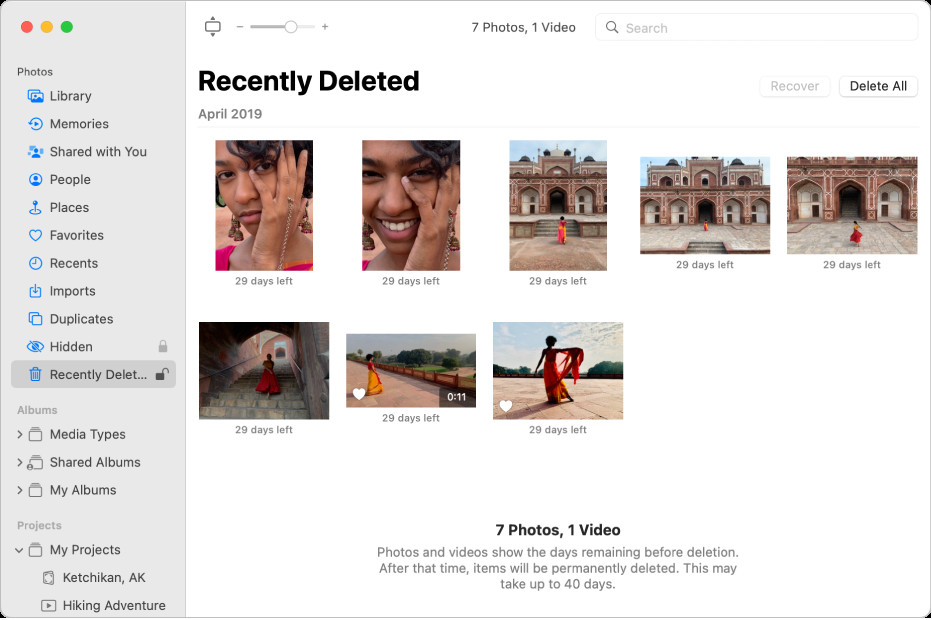Accidentally deleting precious photos from your iPhone can be a distressing experience. Whether it was a slip of the finger or a moment of indecision, the good news is that Apple provides a straightforward way to recover your deleted photos. This guide will walk you through the steps to retrieve those cherished memories, ensuring you don’t lose them forever.
Method 1: Recovering Deleted Photos Directly on Your iPhone
The most common and easiest method to retrieve deleted photos on your iPhone is by using the “Recently Deleted” album. Apple has thoughtfully included this feature as a safety net, giving you a 30-day window to recover any photos you might have deleted. Here’s how to use it:
-
Open Photos and Tap Albums: Begin by opening the Photos app on your iPhone. Once opened, navigate to the “Albums” tab located at the bottom of your screen.
-
Find the Recently Deleted Album: Scroll down the Albums screen until you find the “Recently Deleted” album listed under the “Utilities” section. Tap on it.
-
Unlock if Necessary: If you are using iOS 16, iPadOS 16.1, or later, the Recently Deleted album might be locked for security. Use Face ID or Touch ID to unlock and access the album.
-
Select Photos to Recover: Once inside the Recently Deleted album, you will see thumbnails of your recently deleted photos and videos. Tap “Select” in the top right corner of the screen.
-
Choose and Recover: Tap on each photo or video you wish to recover. A blue checkmark will appear on the selected items. After selecting all the photos you want to retrieve, tap “Recover” at the bottom right corner. If you want to restore all items in the album, you can tap “Recover All”.
-
Confirm Recovery: A confirmation prompt will appear. Tap “Recover Photo” to confirm your action. The recovered photos will be restored to your main Photos Library, appearing back in your Albums and “Recents”.
 The Photos window showing Recently Deleted selected in the sidebar and recently deleted items on the right.
The Photos window showing Recently Deleted selected in the sidebar and recently deleted items on the right.
This process is quick and efficient for photos deleted within the last 30 days. Remember to check your Recently Deleted album promptly if you realize you’ve accidentally deleted a photo.
Method 2: Recovering Deleted Photos from iCloud
If you use iCloud Photos, your photos are automatically synced across all your Apple devices and stored in iCloud. This offers another avenue for photo recovery, especially if you’ve accidentally deleted photos across devices. Here’s how to recover photos from iCloud.com:
-
Go to iCloud.com and Sign In: Open a web browser and go to iCloud.com. Sign in using your Apple ID and password.
-
Open Photos in iCloud: Once logged in, click on the “Photos” icon. This will take you to your iCloud Photos library on the web.
-
Access the Recently Deleted Album: In the Photos on iCloud.com interface, look for the “Recently Deleted” album in the sidebar. If you don’t see the sidebar, click the sidebar icon, usually located in the top corner.
-
Select and Recover Photos: Open the “Recently Deleted” album. You will see the photos and videos you’ve recently deleted from your iCloud Photos. Select the photos or videos you want to recover by clicking on them. You can select multiple items.
-
Click Recover: After selecting the desired photos, click the “Recover” button, typically located at the top of the iCloud Photos window.
 The Photos window showing Recently Deleted selected in the sidebar and recently deleted items on the right.
The Photos window showing Recently Deleted selected in the sidebar and recently deleted items on the right.
The recovered photos will be restored to your iCloud Photos library and will reappear on all devices connected to your iCloud account, including your iPhone.
Method 3: Restoring from a Mac’s Recently Deleted Album
If you primarily use a Mac and have deleted photos from the Photos app on your Mac, you can also recover them from the Recently Deleted album on your Mac. This is similar to the iPhone recovery process:
-
Open Photos App on Mac: Open the Photos application on your Mac.
-
Navigate to Recently Deleted: In the Photos app, find “Recently Deleted” in the sidebar. It’s usually located under “Albums”. If the sidebar is not visible, make sure it’s enabled from the View menu.
-
Unlock if Locked: If the Recently Deleted album is locked (especially if you have set up privacy settings), use Touch ID or enter your password to unlock it.
-
Select and Recover Photos: Select the photos you wish to restore. You can select multiple photos by holding down the Command key while clicking.
-
Click Recover: Once selected, click the “Recover” button. This will restore the photos back to your Photos Library on your Mac.
 The Photos window showing Recently Deleted selected in the sidebar and recently deleted items on the right.
The Photos window showing Recently Deleted selected in the sidebar and recently deleted items on the right.
Conclusion
Retrieving deleted photos on your iPhone is generally a simple process, thanks to Apple’s Recently Deleted feature available across iPhone, iCloud, and Mac. Remember that you have a 30-day window to recover your deleted photos from the Recently Deleted album. After this period, the photos are permanently deleted and cannot be recovered through these methods.
To prevent permanent photo loss, consider regularly backing up your iPhone using iCloud Backup or iTunes (Finder on newer macOS versions). Regular backups ensure that even if you cannot recover photos from the Recently Deleted album, you have another copy safely stored that you can restore from. Regularly managing and backing up your photos will safeguard your precious memories for years to come.
References:
